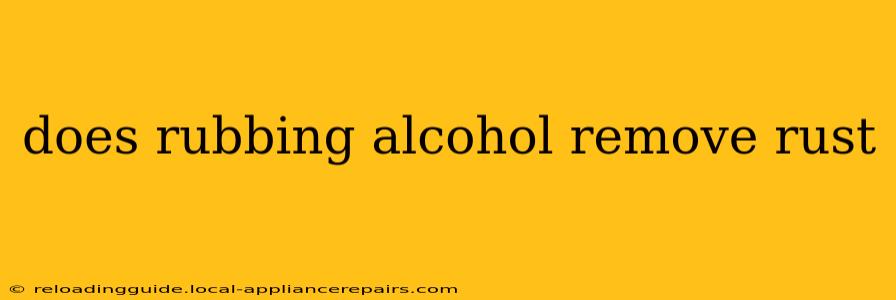Rust. That unsightly orange scourge that plagues everything from antique tools to modern car parts. We've all been there, staring at a rusty object wondering, "Can I save this?" One common household item often suggested is rubbing alcohol (isopropyl alcohol). But does rubbing alcohol actually remove rust? The short answer is: not effectively. While it might offer some minor cleaning benefits, it's not a reliable rust remover. Let's delve deeper into why.
Understanding Rust and its Removal
Rust, chemically known as iron oxide, is the result of iron reacting with oxygen and water. This chemical reaction is irreversible, meaning once iron rusts, the metal itself is chemically altered. This is why simply wiping away the rust isn't sufficient; you're dealing with a fundamental change in the metal's structure.
Why Rubbing Alcohol Falls Short
Rubbing alcohol, typically 70% isopropyl alcohol, is a good disinfectant and cleaner, effectively removing dirt, grease, and some organic matter. However, it lacks the chemical properties necessary to break down and remove iron oxide. It might lightly clean the surface around the rust, giving a slightly improved appearance, but it won't dissolve the rust itself.
What Rubbing Alcohol Might Do:
- Clean surrounding areas: It can clean away dirt and grime that obscures the rust, making the extent of the damage more visible.
- Prepare for other treatments: By cleaning the surface, rubbing alcohol might marginally improve the effectiveness of other rust removal methods applied afterward. Think of it as a pre-treatment, not the primary solution.
Effective Rust Removal Methods
If you're serious about removing rust, you need more powerful solutions. Here are some effective methods:
1. Steel Wool and Abrasive Cleaners:
For light surface rust, steel wool (fine grade) combined with a mild abrasive cleaner can work wonders. This method is effective for removing loose rust particles. Remember to always wear appropriate safety gloves.
2. Chemical Rust Removers:
These products, available at most hardware stores, contain acids (often phosphoric or oxalic acid) that chemically react with the rust, dissolving it. Always follow the manufacturer's instructions carefully, as these products can be corrosive.
3. Electrolysis:
This method uses an electrolytic process to remove rust. It's more involved but highly effective for heavily rusted items. Numerous online tutorials detail how to set up an electrolysis tank.
4. Sandblasting or Media Blasting:
For larger or more heavily rusted items, sandblasting or media blasting is often the most efficient approach. This involves using a high-pressure stream of abrasive material (sand, glass beads, etc.) to remove the rust. However, this is best left to professionals due to the equipment and safety precautions involved.
Conclusion: Don't Rely on Rubbing Alcohol for Rust Removal
While rubbing alcohol might have a place in cleaning the area around rust, it's not a viable solution for rust removal itself. For effective rust removal, consider the methods outlined above. Choose the appropriate method based on the severity of the rust and your experience level. Remember always to prioritize safety by wearing appropriate protective gear when handling chemicals or abrasive materials.

